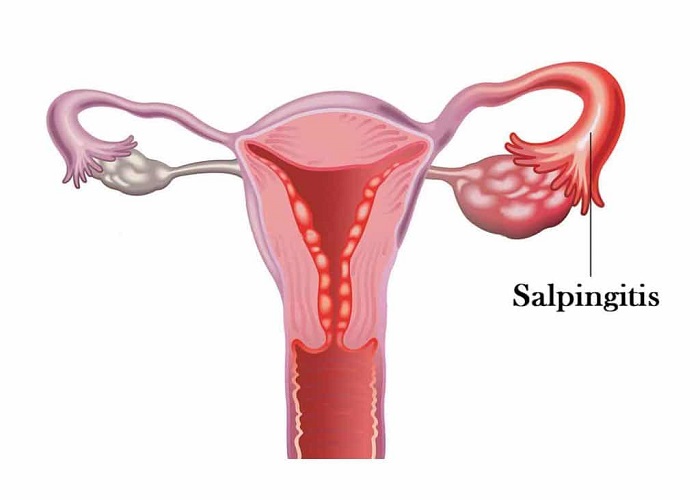It is known as Salpingitis, the inflammation of the fallopian tubes, which are structures located on both sides of the uterus. It causes discomfort in women due to enlargement in the walls of the box since 60% of cases usually involve bilateral growth involving both tubes. This disorder can become a cause of tubal sterility in a woman, so it is essential to undergo regular medical check-ups to be able to detect any alteration in the body and carry out effective treatment.
Salpingitis is also known as Pelvic Inflammatory Disease, better known as PID. However, in this way, it refers more to an infection in the upper genital area, including the uterus, tubes, and ovaries. Although all women are prone to acquiring this disease, the highest incidence occurs in young and sexually active women. If you don’t know much about this pathology, at FastlyHealwe, want to offer you all the details about Salpingitis: symptoms, causes, and treatment.
Table of Contents
Main symptoms of Salpingitis
Although the symptoms of Salpingitis can vary depending on the pathogen that acts, there is symptomatology that occurs in the vast majority of cases, among which are:
- Fever
- Nausea and vomiting
- Irregular menstrual bleeding
- Abnormal color and vaginal odor discharge
- Feeling uncomfortable when having sex can cause some discomfort during them.
On the other hand, Salpingitis can cause pain or cramps in the pelvic area, a more constant urge to urinate but with discomfort when it is performed, significant distress during ovulation, abdominal cramps, and vaginitis inflammation in the vagina.
Causes of Salpingitis
Two main types of Salpingitis can be differentiated, the acute, in which the fallopian tubes become inflamed, favoring that the symptoms are very present and can be very annoying, and the chronic, which can go unnoticed many times and, Often, it manifests after the menstrual period but becomes longer.
This pathology can originate after a vaginal infection by a bacterium such as Mycoplasma, Staphylococcus, or Streptococcus. Still, in general, it is usually caused by a sexually transmitted disease, mainly by a type of chlamydia known as Chlamydia trachomatis. This causes the infection to start in the vagina and work its way up to the upper genital tract.
Only 5% of women with Salpingitis can find the cause in other sexually transmitted pathogens. This alteration variably manifests itself over time, which means that it can begin to appear after several weeks or months after contact with the agent that causes it.
Treatment for Salpingitis
To diagnose inflammation in the fallopian tubes, it is enough for the doctor to carry out some examination tests, such as the Pap smear, a culture with samples of vaginal discharge, and blood tests, as this can confirm if the symptoms correspond to this disease and determine the type of microorganism that is producing it.
As it is a pathology usually caused by bacteria, the doctor is likely to opt for a treatment based on antibiotics and anti-inflammatory drugs that can help alleviate the discomfort while eliminating the bacteria from the body.
If the case is severe, the specialist may choose to hospitalize the woman while they offer treatment to her and her partner. If there is a collection of pus in a pelvic abscess caused by PID, surgery will likely be required to drain the abscess.
It is advised that if you are going through this disease, avoid unprotected sexual relations during the period of treatment; however, if you know or suspect that you suffer from Salpingitis, you should consult a doctor so that they can offer you guidelines for rapid improvement.

Risk factors and complications of Salpingitis
The risk of Salpingitis increases considerably if you have sex with your partner and he has a genital infection, if you had previous pelvic surgery, if you have multiple sexual partners, if you have a history of pelvic inflammatory disease, or if you use IUD, that is, the intrauterine device as a contraceptive method.
If you have Salpingitis, some complications that may appear are:
- A general infection.
- Chronic pelvic pain
- Ectopic pregnancy.
- EIP repeatedly.
- Sterility of tubal origin.
- The appearance of a pelvic abscess with pus.
This article is merely informative. At FastlyHeal .com, we do not have the power to prescribe medical treatments or make any diagnosis. We invite you to see a doctor in the case of presenting any condition or discomfort.
If you want to read more articles similar to Salpingitis: symptoms, causes, and treatment, we recommend that you enter our category of Female reproductive system.

I am a Surgeon with a diploma in comprehensive ultrasound and surgical care residency, an area I am specializing in. During the exercise of my profession, I have realized the need for patients to know the diseases they suffer, and I can tell you that a large part of their complications is due to a lack of information. Being a health web writer allows me to transmit my experience, without borders, to all those readers eager for knowledge, educate them in the prevention of diseases and promote a healthy lifestyle.

